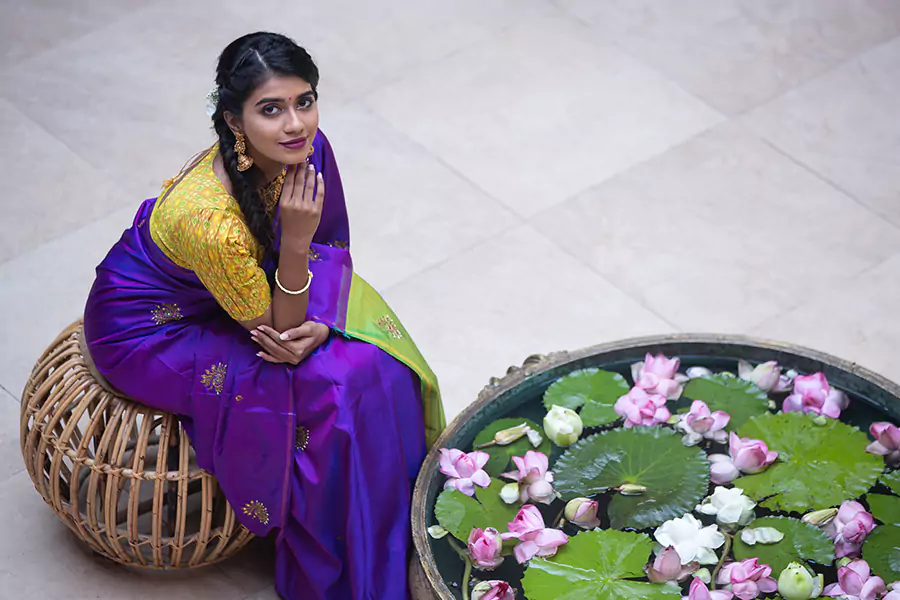
A bridal trousseau or an Indian woman’s wardrobe would be lacking without one extremely significant item: the iconic Kanjeevaram Sarees. Women wear various silk sarees at all events and festivals, from the most wealthy leaders to the most modest households.
The Kanjeevaram sarees, also known as the “queen of silks,” is a popular dress choice for special occasions that are frequently meaningful and life-altering, occasions that serve as indicators of change and growth as well as the start of a stage in a person’s life and journey.
The unique features of Kanjeevaram sarees
- Wide Contrast Borders and Colors: The Kanjeevaram Sarees are distinguished by their use of two or three warps dyed in different colours and woven together by the most meticulous interlocking technique. This contrasts with most Indian textile genres woven with a single warp.
The Korvai method of weaving enables the colour interplay that characterises this style and elevates each Kanjeevaram Sarees into a work of art. You can rest assured that this beautiful saree won’t fall apart at the seams, even if you are clumsy or wear it while walking.
- The Zari’s Secret Ingredient for the Gold Glimmer: The golden zari weaving process takes a lot of time and patience. The yarn is prepared and twisted together in several ways to create beautiful and intricate designs.
Therefore, if you’ve ever wondered why Kanjivaram silk has a golden sheen on clothes without a gold colour foundation, now you know! These gorgeous Kanjeevaram sarees have a metallic sheen from the thread itself, which gives them personality. - Motifs and design: Temple borders, checks, stripes, and floral motifs are traditional designs seen on Kanjeevaram sarees. These designs were inspired by images and scriptures found in South Indian temples and other natural elements like leaves, birds, and animals. The complexity of the work, colors, patterns, and materials used, such as Zari (gold thread), all play a role in how diverse they are.
- A Symbol of Endurance or Legacy: The 240 warps and 250 wefts used to create the 6-yard marvel weave make it nearly impossible to rip apart. The Zari’s three silk strands are twisted with a silver wire to increase the weave’s tensile strength. But doing so may also increase the weight, making traditional Kanjeevaram sarees heavier than those made of other silks.
Origin and History
Early Hindu mythology is where the history of the Kanjeevaram silk sarees began. The Kanchi silk weavers are reputed to be decedents of Sage Markanda, who was regarded as the Gods’ master weaver. The name of the timeless weave comes from Kanchipuram in Tamil Nadu, where two significant populations of weavers from Andhra Pradesh went to produce the Kanjeevaram sarees. They produced the kanjivaram, a 9-yard philosophy that featured representations of legendary texts and statues from nearby temples.
Taking Care
- Kanjeevaram Sarees should always be professionally dry cleaned. If you feel comfortable doing so, please space out the cleaning intervals to once every two to three usage.
- After each use, let the Kanjeevaram sarees air as much as possible before dry cleaning them and restoring the folds with a roller iron. To prevent a permanent fold mark on your Kanjeevaram sarees, alternately change the crease of the fabric periodically.
- Use the spot cleaning method to remove stains from Kanjeevaram sarees, but we always advise professional dry cleaning.
- Additionally, never beat, rub, or twist your Kanjeevaram sarees. Avoid letting it air in the sun.
- To prevent fungus from growing on the Kanjeevaram sarees, use silica gel bags to absorb additional moisture.
Conclusion
The Indian government designated the Kanjeevaram silk sarees as a Geographical Indication in 2006 to preserve their splendour.